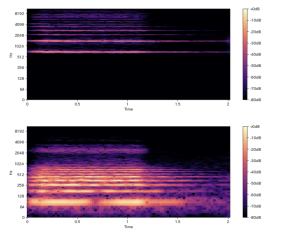短時間フーリエ変換、MFCCを利用する
import numpy as np
import librosa
import librosa.display
import os
import matplotlib.pyplot as plt
from sklearn.model_selection import train_test_split
from sklearn import svm
from scipy import fftpack
# 音声データを読み込む
speakers = {'kirishima' : 0, 'suzutsuki' : 1, 'belevskaya' : 2}
# 特徴量を返す
def get_feat(file_name):
a, sr = librosa.load(file_name)
y = np.abs(librosa.stft(a))
plt.figure(figsize=(10, 4))
librosa.display.specshow(librosa.amplitude_to_db(y, ref=np.max), y_axis='log', x_axis='time', sr=sr)
plt.colorbar(format='%+2.0fdB')
plt.tight_layout()
return y
# 特徴量と分類のラベル済みのラベルの組を返す
def get_data(dir_name):
data_X = []
data_y = []
for file_name in sorted(os.listdir(path=dir_name)):
print("read: {}".format(file_name))
speaker = file_name[0:file_name.index('_')]
data_X.append(get_feat(os.path.join(dir_name, file_name)))
data_y.append((speakers[speaker], file_name))
return (np.array(data_X), np.array(data_y))
# data_X, data_y = get_data('voiceset')
get_feat('sample/hi.wav')
get_feat('sample/lo.wav')

speakers = {'kirishima' : 0, 'suzutsuki' : 1, 'belevskaya' : 2}
# 特徴量を返す
def get_feat(file_name):
a, sr = librosa.load(file_name)
y = np.abs(librosa.stft(a))
# plt.figure(figsize=(10, 4))
# librosa.display.specshow(librosa.amplitude_to_db(y, ref=np.max), y_axis='log', x_axis='time', sr=sr)
# plt.colorbar(format='%+2.0fdB')
# plt.tight_layout()
return y
# 特徴量と分類のラベル済みのラベルの組を返す
def get_data(dir_name):
data_X = []
data_y = []
for file_name in sorted(os.listdir(path=dir_name)):
print("read: {}".format(file_name))
speaker = file_name[0:file_name.index('_')]
data_X.append(get_feat(os.path.join(dir_name, file_name)))
data_y.append((speakers[speaker], file_name))
return (data_X, data_y)
data_X, data_y = get_data('voiceset')
train_X, test_X, train_y, test_y = train_test_split(data_X, data_y, random_state=11813)
print("{} -> {}, {}".format(len(data_X), len(train_X), len(test_X)))
def predict(X):
result = clf.predict(X.T)
return np.argmax(np.bincount(result))
ok_count = 0
for X, y in zip(test_X, test_y):
actual = predict(X)
expected = y[0]
file_name = y[1]
ok_count += 1 if actual == expected else 0
result = 'o' if actual == expected else 'x'
print("{} file: {}, actual: {}, expected: {}".format(result, file_name, actual, expected))
print("{}/{}".format(ok_count, len(test_X)))
MFCC
def get_feat(file_name):
a, sr = librosa.load(file_name)
y = librosa.feature.mfcc(y=a, sr=sr)
# plt.figure(figsize=(10, 4))
# librosa.display.specshow(librosa.amplitude_to_db(y, ref=np.max), y_axis='log', x_axis='time', sr=sr)
# plt.colorbar(format='%+2.0fdB')
# plt.tight_layout()
return y
o file: suzutsuki_b06.wav, actual: 1, expected: 1
o file: kirishima_04_su.wav, actual: 0, expected: 0
o file: kirishima_c01.wav, actual: 0, expected: 0
o file: belevskaya_b04.wav, actual: 2, expected: 2
o file: belevskaya_b14.wav, actual: 2, expected: 2
o file: kirishima_b04.wav, actual: 0, expected: 0
o file: suzutsuki_b08.wav, actual: 1, expected: 1
o file: belevskaya_b07.wav, actual: 2, expected: 2
o file: suzutsuki_b03.wav, actual: 1, expected: 1
o file: belevskaya_b10.wav, actual: 2, expected: 2
o file: kirishima_b01.wav, actual: 0, expected: 0
o file: belevskaya_07_su.wav, actual: 2, expected: 2
12/12
MFCC凄すぎんだろこれ
